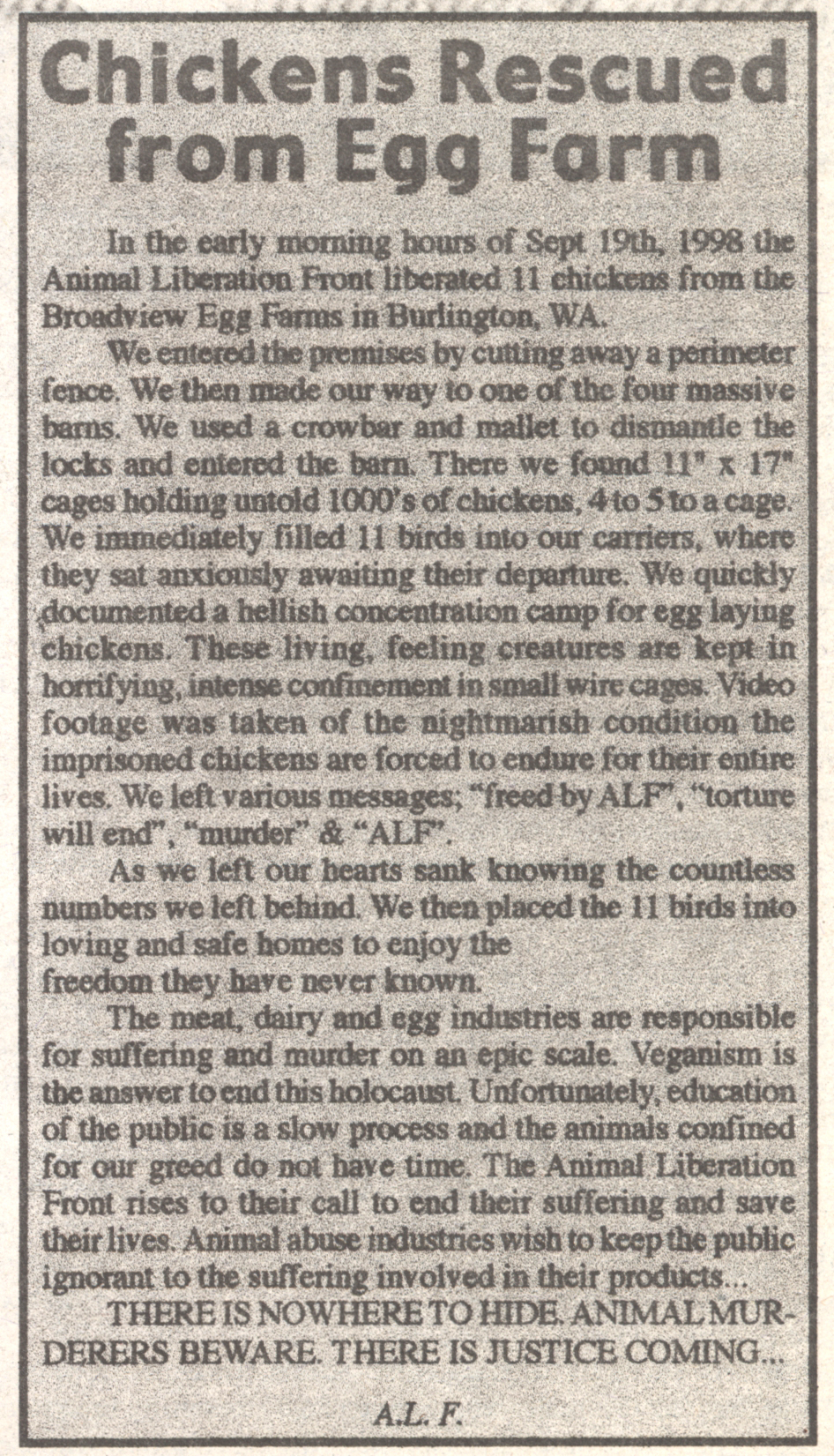Category
Videos
-
Videos
Heart of the Matter: South East Animal Liberation League
Heart of the Matter: South East Animal Liberation League (1984. London, England)
Recently the South London Flying Column YouTube channel has been posting video of old news coverage of animal rights related direct action. There are many, many gems on there, but we were particularly enamored of this piece, a 20 minute episode of the program Heart of the Matter. Besides containing never before seen footage of raids carried out by SEALL, it also contains unbelievable footage of an unmasked ALF planning session! And if you find yourself disliking the SEALL spokesperson, it’s okay. He didn’t actually turn out all that well…
…
-
Videos
Scott Crow and Josh Harper on Anarchism and Animal Rights
Back in early June Portland, OR. was host to the amazing Resistance Ecology conference. Videos of the various panels are slowly being posted at the Burning Hearts Media TUMBLR, but we figured we would share a few of them here as well. First up is TALON co-founder Josh Harper and dirty south rabble rouser Scott Crow on the topic of anarchism and animal rights.
…
-
Videos
From the Vaults: Broadview Egg Farm Raid
Undercover ALF video: Broadview Egg Farm (1998. Burlington, WA)
Throughout the mid to late 1990’s at least one illegal direct action happened somewhere in the United States every day. Many of these actions were somewhat futile- at least on their face. While it is true that a glued lock or a spray painted wall means very little to companies like McDonalds, it is also true that no one is born with the skill set to make revolutionary change for non-humans. We can only learn through trial and error, and gaining the confidence to undertake bigger actions often starts with something small like breaking a window.
Fortunately, actions that are unlikely to gain public sympathy aren’t the only low-risk way to build confidence and save lives. Consider, for example, egg farms. Although egg consumption in the United States is declining, battery farms are still everywhere. They are easy to find, largely unprotected, and simple to enter. The animals housed on these farms are in desperate need of liberation, and the only difficulty in doing so is finding them homes. In today’s era of urban chickens, this is getting easier. Any vegan with a back yard and the resources to buy or build simple housing could provide one of these beautiful creatures with a better life.
In 1998 one small group of people decided to raid an egg farm in Burlington, Washington. They shot a video of the action and distributed it to media outlets and supportive activists. Most of the news coverage was positive, 11 chickens were saved from a short life of misery and imprisonment, and I like to imagine that the action had a positive, skill building effect on the activists themselves.
Presented below is the video itself, along with the media statement sent by the rescuers.
…
-
One-off publications, Videos
Hidden Crimes
Hidden Crimes (1986. Pasadena, CA)
The animal liberation movement has seen some bewildering strategies come and go over the years. One of the weirdest was the idea that animals should be removed altogether from the vivisection debate. As far back as the 1970s there were groups and individuals who insisted (often with religious zeal) that the issue with animal experimentation was one of scientific fraud, and that humans were too selfish to care about animals. These anti-vivisectionists thought that if the general public could be convinced that vivisection did not work, people would be outraged by the waste of their tax dollars and would demand that the practice ended.
The idea that the public would revolt if they saw their tax dollars wasted on “scientific fraud” is absurd. How many people living in the United States are already aware of ways in which their tax dollars are abused and how many are rioting as a result? How many of those involved in the fight against vivisection would fight with the same force for money instead of lives? Furthermore, since this who strategy relied on the idea that “Vivisection is Scientific Fraud,” what percentage of the public is qualified to debate science with scientists? Finally, if vivisection were to be defeated using this strategy, where does that leave animals killed for fur, food, and entertainment? Were they to be abandoned since the selfishness of humanity is all we had to appeal to?
Despite these obvious weaknesses in their argument, groups like SUPRESS, and their founder Javier Burgos, made several documentaries promoting the idea. The first by SUPRESS was called “Hidden Crimes,” and despite its message that fraud is more of an issue than animals, graphic imagery of animals being mutilated is prominent throughout the film. Much of this footage was obtained by the Animal Liberation Front, who notably fight vivisection because of their concern for non-humans, rather than bad science or mis-spent tax dollars.
Hidden Crimes promised to be the start of a new movement which would swiftly abolish vivisection. If failed to keep that promise, but for all of its faults, it was seen by tens of thousands of people upon its release and remains an important part of our movements history.
…
-
One-off publications, Videos
Breaking Barriers
11.27.12 | Permalink | Comments Off on Breaking BarriersBreaking Barriers (1986. Washington, D.C.)
While it is true that direct action is often the best means to accomplish our goals, the way we conduct those actions can be an impediment to long term change. Early militants in the animal liberation movement were inspired by the aesthetics of groups like The Angry Brigade, and we have been saddled with that sort of ski-mask and army jacket imagery ever since. The problem is this: that appearance is heavily associated with anti-social behavior, crime, and random violence. While we may romanticize the bolt cutters and balaclavas, the general public does not. If our fashion sense harms the propaganda and recruitment value of our actions, than perhaps we need a makeover.
There have been efforts to part with the bank-robber-meets-gun-nut costumes, however. One of the most dramatic involved a spectacular raid, and… um… mime masks. This attempt at softening the imagery of underground activism was carried out by the aptly named “True Friends.” The video below, Breaking Barriers, was produced by PeTA in their more radical days, and acted to publicize the liberation of four baby chimpanzees from isolation chambers at the SEMA lab in Rockville, MD. While the effectiveness of their eerie masks and wigs is questionable, the beauty of these young primates being freed from a life of torture is not. This was a notable raid that garnered considerable public sympathy when it occurred, and just because the attempt at re-inventing our look failed in this instance doesn’t mean we shouldn’t keep trying.
…
-
One-off publications, Videos
90s ALF press coverage: Alaskan Fur Co. and USDA arsons.
08.02.12 | Permalink | Comments Off on 90s ALF press coverage: Alaskan Fur Co. and USDA arsons.Random clips (1996 and 1998, various locations.)
Speciesism is so entrenched that your average person sees nothing wrong with the anal electrocution of a mink in order to steal their fur. This same person, however, will scream bloody murder over an empty building being set alight to prevent such torture. Our society habitually denounces those who resist our everyday cruelties, until somehow logic manages to penetrate and suddenly the rebels are seen as being right all along. At one point in the United States the majority of (invading European) citizens saw nothing wrong with human slavery, and newspapers shouted their outrage over slave revolts, the underground railroad, and the burning of auction blocks that sold thousands of people into bondage. Through the efforts of generations of abolitionists, however, the tide was eventually turned, and none of those aforementioned papers would now dream of supporting the slave trade. The rebels who were hated by the public, who were jailed and hanged and ridiculed to the delight of the media, are now seen as heroes.
There are, of course, very real differences between the movements to end human and non-human slavery, but the role of the media has remained very much the same. Luckily our movement has had, from time to time, articulate spokespeople who can explain why direct action is taken on behalf of animals. In the 1990s Freeman Wicklund, then the publisher of No Compromise magazine, would act as a press liaison in order to explain the motives of the underground. Later, Katie Fedor would start the North American Animal Liberation Front Press Office. Working closely with former ALF prisoners and the Canadian SG, she appeared regularly on television defending the actions of anonymous saboteurs. (As an interesting side note, Kevin Kjonaas once interned for Katie’s press office, and actually received college credits for defending the ALF!)
We present here several news clips featuring Freeman and Katie in the 90s doing one of the hardest jobs a good press officer must do: defending the use of arson to save animals.
…
-
Most Popular, Periodicals, Videos
SHAC Revisited
07.02.12 | Permalink | Comments Off on SHAC RevisitedSHAC USA Newsletters, Various Issues (2001-2006, Philadelphia, PA)
Diaries From Hell (2001, Princeton Junction, New Jersey)
The Mandate & Strike Back – Shac Videos (2002, Philadelphia, PA)Today marks the end of a very long journey for me. After more than two years on pre-trial release, eight months on house arrest, three years in prison, and three years on probation, my life is now my own again. As of this morning I no longer need to fill out monthly reports, open my home to law enforcement at any time without probable cause, give the government constant access to my e-mail and social media accounts, or stay confined within the western district of Washington. Best of all, I can return to the kind of organizing that I love and live the life of conscience that I committed myself to so many years ago.
The people who took away my freedom did not do so because I was breaking the law. In fact, they knew that I was not doing so. FBI documents show that I was under almost constant surveillance for years of my life. One field office after another followed me in an attempt to prove that I was “the nexus of illegal [animal and earth liberation related] crime in the Northwest.” They hired informants to befriend me, went through my garbage, paid off my mail carrier to write down the return addresses of my incoming mail, attempted to entrap me, raided my home… the list could go on and on. In the end they had some tapes of lectures I gave advocating forms of hacktivism, and for that speech activity I had my life interrupted for the better part of a decade. An appeals court later said this about my conviction: “Harper’s personal conduct does not cross the line of illegality; to punish him simply on the basis of his political speeches would run afoul of the constitution.” They then went on to uphold my conviction.
If all of the years stolen from me were not about crimes I had committed, what was the government’s motivation? The answer to that question is complex, but I believe the primary concern for the ruling class was that I had begun to see through their illusions of status and power. I know how grandiose- even absurd- that may sound, but please bear with me for just a moment. I was born to working class parents so poor that my first crib was made from a dresser drawer. My mother worked in convenience stores, cleaned homes, and toiled away her health in a frozen foods warehouse. My father was a Vietnam veteran who had survived a fire in the tank he was driving. The horror that he experienced in our government’s imperialist venture in south-east Asia colored every moment of our home life. He returned from his time in the army addicted to drugs, disabled, and in constant pain from shrapnel that was still lodged in his skull. He worked off and on as a mechanic and small time drug dealer. This is the situation that I was raised in, but I am not complaining. My parents loved me and my sister, and despite their mistakes they did their best to help me become a good person. My dad once saw two cops harassing a homeless man outside of a 7-11. They kept asking him if he was “an illegal” and made several references to his race, repeatedly calling him “amigo.” Everyone sat in their cars and watched. Everyone except for my dad, who got out and challenged the police. That moment taught me more than any private school or university ever could have. And while my mom couldn’t always afford the clothing that I selfishly demanded when I was kid, she never bowed down to anyone higher on the social ladder. When some entitled rich kid gave her shit at work, she gave it right back and then some. My heart swells with pride when I think about the warning she got from her bosses at one job: she was required to provide service to police officers and had better begin doing so or else she would be fired. After years of seeing the cops in Eugene, OR beat and harass the underclass she wouldn’t sell them coffee and doughnuts, and continued in her disobedience even when her job was on the line.
I always knew that no matter what my economic status was, that my life was just as valuable as that of a billionaire or a president. I do not care about their titles or money or connections, but I began to care an awful lot about their abuses of power. The wealthy elite, who strip this planet of its life support system, who benefit from racism, sexism, and homophobia, who view our non-human kin as machines for profit, who turn the masses against each other, are made of flesh and blood just like you and I. They want us to believe in corporate personhood because it distracts from the man behind the curtain, the vulnerable decision makers who use towers of steel and concrete to appear more powerful.
This was the threat of Stop Huntingdon Animal Cruelty; we saw through all of the social conditioning that tells us that we are too weak to effect change. We went straight to the homes of those in power, challenged them on their golf courses, screamed at them while they vacationed at summer homes. We were the barbarians at the gate, an alliance of the kind of people who did not usually get heard by the mega-rich of the world. Tooth and nail we went after their profits, and along the way refused to divide and fracture over broken windows or graffiti. Everyone was welcome if they would fight, and I smile so big it hurts when I think of the grandmothers, the punks, the students, and all the other unlikely comrades who marched together in defiance of the false hierarchy that tells us to keep separate and leave the rich to their own devices. We didn’t stay in our place. In fact, we recognized that our place was wherever the hell we chose, and the world of finance and animal abuse was rocked as a result.
This isn’t to say that we were perfect. We made so many mistakes, and we must be accountable for them. As Conflict Gypsy completes its archives of Huntingdon Life Sciences campaign materials we will be critical of the movement’s failures. But today, as I leave Washington to see my family and friends and celebrate my new freedoms, I hope that the spirit of the campaign will infect you. All of us have a revolutionary spark in our hearts, and together these individual sparks provide a beautiful warmth that melts away the cold sterility created by our rulers. Together we can turn the tide of ecocide, of prejudice, of economic and political exploitation. Never, ever believe otherwise.
For animal liberation, for global revolution, and for joy! Yours always,
Josh Harper
July 2nd, 2012




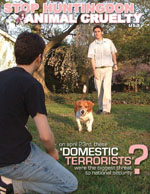

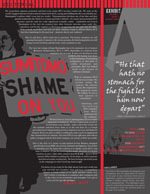


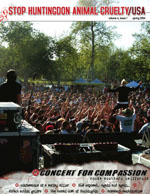




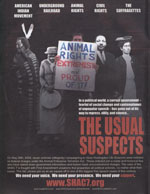


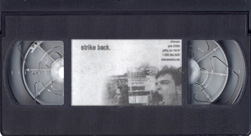
…
-
One-off publications, Videos
Angels of Mercy?
03.22.12 | Permalink | Comments Off on Angels of Mercy?Angels of Mercy? (1995, London, England)
In 1995 Channel 4’s Warcries news program aired Angels Of Mercy?, a 30 minute investigation into the Animal Liberation Front. The show focused primarily on Keith Mann, an ALF volunteer who was then serving England’s longest sentence for animal rights motivated arson. While most commercially funded news has a clear bias in favor of the status quo (and the channels sponsors,) Warcries was known for fairer journalism. The result in this case was a surprisingly sympathetic look at what pushes a young person to commit criminal acts on behalf of non-humans. Given developments since it first aired, it also serves as a remarkable lesson about public credibility and how difficult it is to regain once lost.
In the 1990s our movement had a variety of articulate, savvy spokespeople, and the release of Angels of Mercy? quickly made Keith Mann foremost among them. His voice-overs from a prison phone are heard over shocking footage of animal abuse, and interviews with his family and supporters act to assure the audience that he is a rational and passionate activist working to stop what can only be described as horrific cruelty. When Keith was later released from prison he was highly sought after as a speaker and a source for reporters. I always felt reassured when I saw his face in the news since I knew it meant that at least one positive quote would make it’s way to the public.
Sadly, in the last few years Keith has become a devotee of British new-age guru David Icke, a man who believes that a race of reptilian shape-shifters secretly controls the world, that cancer is a fungus, that some humans are actually half-dead, inter-dimensional beings, and a host of other pseudo-scientific nonsense. After being literally laughed off of television in 1991 when he wrongly predicted the end of the world, he has resurfaced in recent years as a lecturer and author with a depressing number of followers.
Since his conversion to odd-ball conspiracy theorist Keith Mann has lost much of his credibility both inside and outside the movement. Most recently he has become a holocaust denier, thereby severing his ties with many of us who still held some hope that he would come to his senses. It’s a shame, because as I watch Angels of Mercy? I am reminded of the rare power he once had to make everyday people understand direct action and animal liberation, a power whose benefit is now lost to the animal nations. It is my hope that by posting this video others will consider how desperately the animals need trustworthy advocates, and how easy it is to damage that trust.
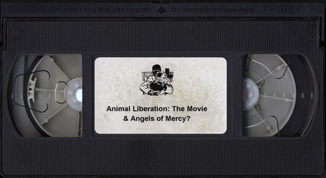
-
One-off publications, Videos
Animal Liberation: The Movie
02.07.12 | Permalink | Comments Off on Animal Liberation: The MovieAnimal Liberation: The Movie (1992, England)
An early and wonderful example of DIY video production and anonymous distribution, Animal Liberation: The Movie was brought to the US by Freeman Wicklund in the early 90s. Often sold on the same tape as the moving Kieth Mann documentary “Angels of Mercy,” it quickly became a must have in the video collection of activists everywhere.
Documenting the high-water mark of daylight raids, department store arson, hunt sabotage, and undercover investigations in England, this sub-rosa video remains one of the best catalogs of direct action in the 80s and early 90s.

-
Periodicals, Videos
Breaking Free Video Magazine #2
12.19.11 | Permalink | Comments Off on Breaking Free Video Magazine #2Breaking Free #2 (1999, Eugene, OR.)
The second and final episode of Breaking Free has some glaring faults: jokes that are not funny, computer animation that is antiquated and was already embarrassing upon it’s release, and no shortage of bad titling choices. It also contains footage of some of the most important and influential campaigns of the era it was produced, especially the Consort Kennels and Hillgrove protests which eventually led to the international fight against Huntingdon Life Sciences. Many long forgotten ALF raids are also shown, along with the final major civil disobedience actions at the end of the voluntary arrest era of the 1990s.
…
